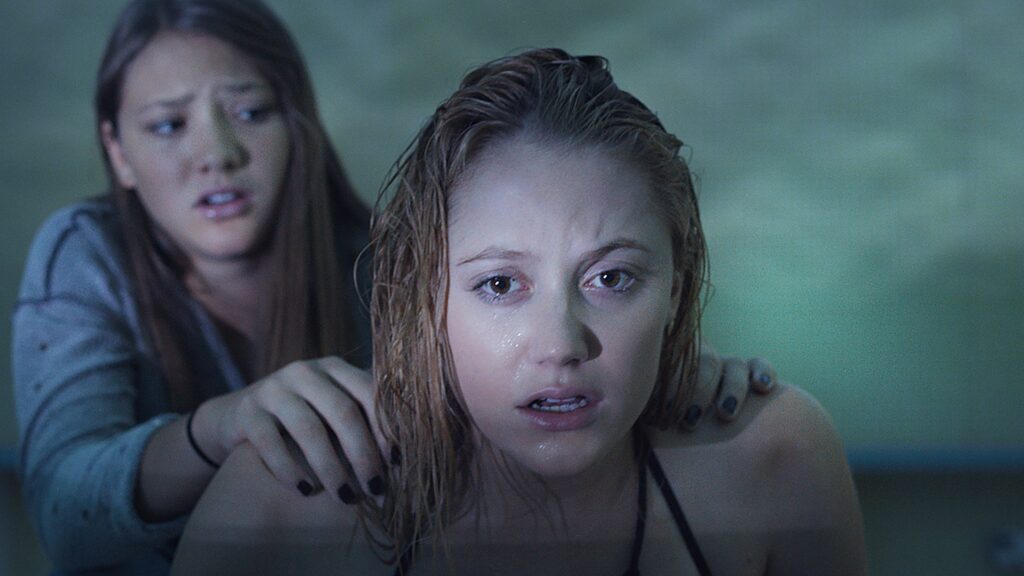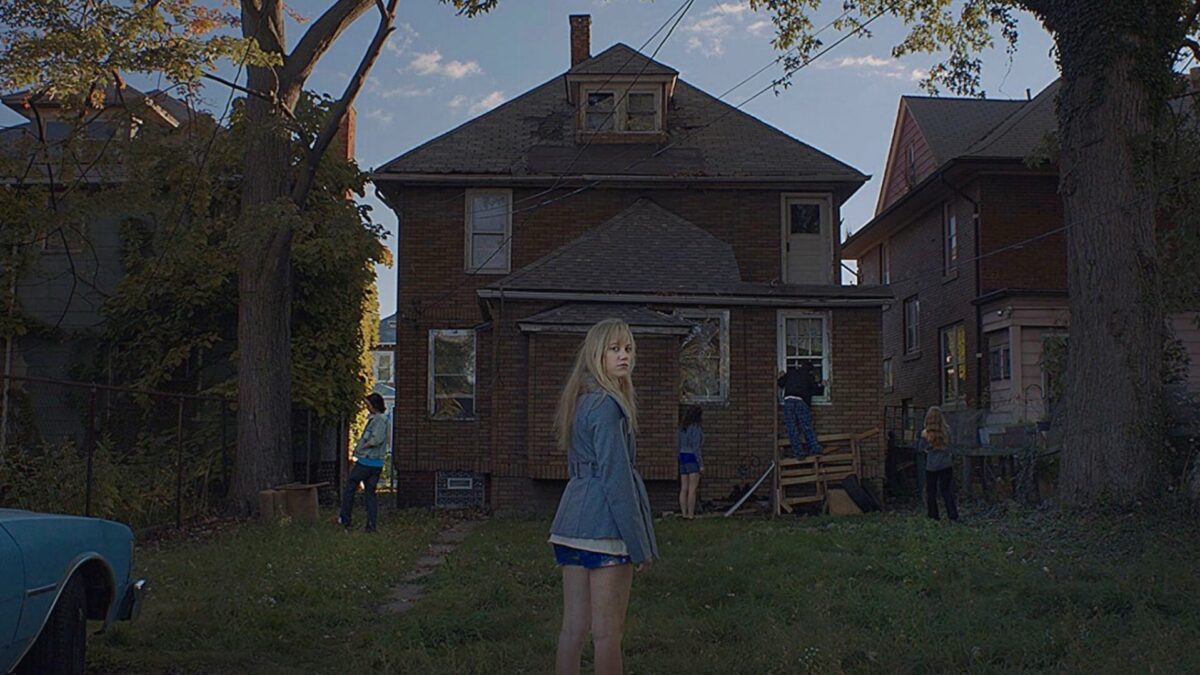You can do It!
So, what is “It,” anyway?
If you’ve seen the movie, surely you have your own answer. Most commentary on the film has included some theory or proposition. I’ll get to my answer in a moment, but first I need to admire what David Robert Mitchell has created here. It Follows, Mitchell’s second film following the dreamy, lo-fi, jokeless hangout comedy The Myth of the American Sleepover, is a remarkable horror film that is not only conceptually audacious but sticks the landing.
Mitchell takes the content that’s barely even subtext in every slasher dating back to 1978’s Halloween and rips it to the surface: The association between sex and death. The film opens with Jay (Maika Monroe) dating cool-guy Hugh (Jake Weary) and finally hooking up in the backseat of his car. In a subversion of expectations, it’s only after coitus that he chloroforms and abducts her, explaining when she wakes up that he has just transferred a curse to her.

Now, and for the rest of her life, she will be constantly followed by a murderous creature. It. (No, not Pennywise.) Like Michael Myers, this deathly vessel emerges from shadows and slowly stalks towards her in a straight line, breaking down doors and even walls to get to her. When It reaches her, she will die a gruesome death. But, by contrast to “The Shape” (Myers’ officially credited character name), the thing stalking Jay will shift bodies, always taking form as some primordial figure of the subconscious: an old crone, a tall dark stranger, a little girl, a shamelessly nude woman, etc. Additionally, only she can see the monster — other people may see the damage it wreaks, but not the thing itself.
The only way that Jay can “escape” It is to pass it on to someone else by sleeping with them. The rules are a little complicated and unintuitive, which is one of my few marks against It Follows: The sex-curse transfer parameters are a bit backwards-engineered to give us the scares and kills in an order that is most thematically and suspensefully potent rather than logical. This took me out of the film a couple of times.
Joining Jay for most of the runtime are a few other teens: There’s Jay’s friend Yara (Olivia Luccardi) and her sister Kelly (Lili Sepe). More crucial to the story and its themes, there are two boys: First is the sensitive nice guy Paul (Keir Gilchrist) who barely bothers hiding his crush on Jay. Second is the aloof hunk Greg (Daniel Zovatto) who is disinterested but effortlessly sexy in a way that makes guys like Paul envious. Together, the group try to make sense of Jay’s curse and find a way out. Their behavior is mostly rational (run the hell away from it and stick together) up until the climax when they concoct a daffy scheme to kill the creature — who is by all evidence invulnerable — by electrocuting it in a pool.

I find the film’s concept to be compelling: It’s not quite a subversion of horror tropes, but it’s still operating outside the normal storytelling mode for the genre. It lampshades the very topics that make pop horror movies like slashers tick. It also weaponizes an important factor in horror: a threat’s inevitability and inescapability is as psychologically terrifying as confronting the threat itself. The film basically splits its time between Jay dodging the creature and Jay suffering from the mental fatigue of constantly dodging it. The cycle is a bit repetitive, yet those scenes of her brooding are terrifying themselves; because we’re in Jay’s perspective, the threat that It could appear anytime is omnipresent.
Mitchell’s construction of all of this absolutely terrific. The tone is not quite so hazy and dreamlike as The Myth of the American Sleepover, but it’s not too far off at certain moments. His signature maneuver in this film is a steady, 360-degree pan. The film opens with one of these shots, a haunting mini-masterpiece that subsumes us in dreary and disorienting suburban terror then smash-cuts to cruel violence. Later, he uses the technique in my single favorite shot of the film, a slow 720-degree pan of a high school that shows nothing out of the ordinary, yet is so pregnant with danger that it’s hair-raising. Any wandering stranger could be a murderous entity, even the most ordinary loser walking to Spanish class.
Mitchell also leverages some half-formed symbolism and visual motifs that don’t quite fit into the theme. They’re evocative nonetheless. His favorite is water. The movie opens with Jay swimming in a pool, and the climax takes place in a pool. She visits lakes and beaches. The half-conscious, submerged feeling of a dream is the film texture he’s going for, so it fits. Another frequent motif is sitting: A dozen or so shots are of someone on a chair or a sofa, but if there’s symbolic content to this, it evades me. One more recurring image is characters spontaneously disrobing to their skivvies, but never in a sexy way. This seems an intentional U-turn on nudity in slashers.

The editing is superbly timed; the acting (a big downside of The Myth of the American Sleepover) is solid throughout; and the cinematography is wonderful — gray and autumnal and tinged with teal. But I really want to call out the score by ambient/electronic artist Disasterpeace, who delivers a terrific homage to ‘80s horror. It’s in the vein of Carpenter’s work in Halloween, but a bit more fractured. It’s used sparingly but memorably, boosting the spine-tingly mood.
So, yeah, excellent horror film that still stands out even with the long trail of “elevated horror” films that replicated It Follows’ serious, thoughtful tone in the years since. It’s not a perfect film; in particular, I wish the ending had more punch. But back to the question at hand: What is It?
One option is that It is a big metaphor for sexually transmitted infections; or, more broadly, the sexual terror of infection and pregnancy. Certainly some of the language used in the script codes It this way very directly. It’s not hard to see why: the curse is transmitted by sex and it haunts you, casts a pall upon you, and makes you a danger to all future sexual partners.
But I don’t think this is the only possible reading. Critic Mike D’Angelo proposes that It is heartbreak. Your first adult love will inevitably break you: you are cursed to lose them at some point in the near or distant future, and you’ll never be the same. The more you fight heartbreak, the worse it hurts. The surest way to heal, to protect yourself from It, is to fall in love with someone else, a reading reinforced by the final shot of the film.

To me, the answer is neither of these, or, really, both of these. It’s the death of innocence that accompanies coming of age. The inherent violence of sex. The curse of sexual awakening that enters our body and never leaves it. The paradoxical fear of both loneliness and intimacy that always lingers, just out of reach, in perfect balance with each other, for all our adult lives. The inevitability of death at war with the Darwinian urge to breed. La petite mort. “Deadfuck.”
And that’s what I love about It Follows: As much as it dares you to read it as a strict allegory, it’s just amorphous enough to both support and refute any over-literal analogy. Scary, distinctive, and memorable, it’s one of my favorite horror movies of the past 10 years.
Is It Good?
Very Good (6/8)
Dan is the founder and head critic of The Goods. Follow Dan on Letterboxd. Join the Discord for updates and discussion.


6 replies on “It Follows (2014)”
I was never as in love with this as some, but I ought to watch it again now that it’s been ten years. (I got a copy cheap ages ago, so it wouldn’t even be an inconvenience.)
Had the strangest theater experience with it, this being back in the days where one still bought their tickets at a box office, and the lady actively advised my girlfriend and I to not watch it because it was terrible. Never happened before or since, and in a sense the oddest thing about it is that It Follows doesn’t seem like a movie anybody could despise *that* much–feels like indifferent dislike ought to be the limit.
I’ve definitely seen plenty of movies where I feel a warning born of visceral, irrepressible hatred would be *way* more appropriate and comprehensible.
(Such as, for a non-random example, Longlegs. Reminds me, is this Maika Monroe catch-up or just a whim?)
Not specifically a Monroe retrospective, but I did think of it because of her in Longlegs, and it’s not like her presence made me less inclined to watch. I saw Mitchell’s debut months ago and had been meaning to watch this at some point. (I’ll probably hit Longlegs once it starts streaming.)
I wonder if that lady was still working at the box office when Beau is Afraid hit theaters. I want her take on the attic penis monster.
Yeah it’s not an all timer, a bit too repetitive, but I think I like Mitchell’s brand of dream logic storytelling. Very curious about Under the Silver Lake.
In all honesty, a horror film embracing symbolism and suspense over logic strikes me as more of a feature than a bug – isn’t a key element in any horror the gradual or brutally sudden breakdown of everyday life, even to the point of logic being chewed up into illogic?
Hence why Us is probably my favorite Jordan Peele flick so far